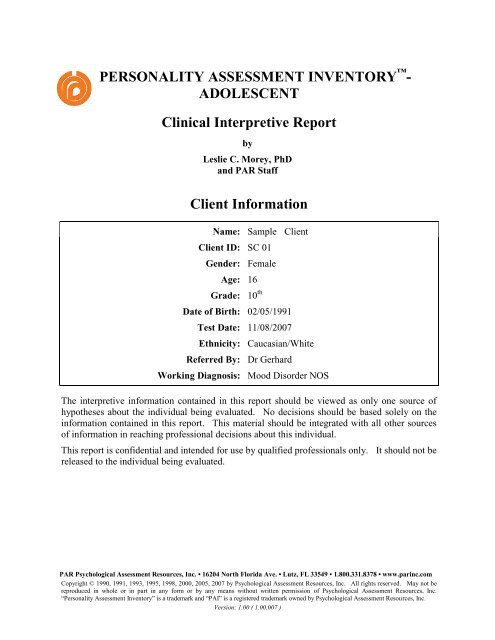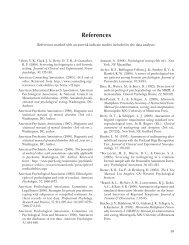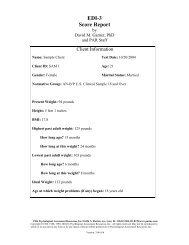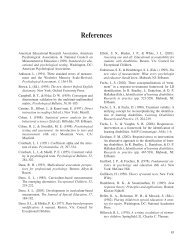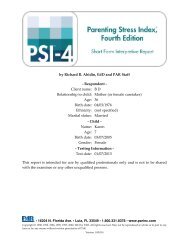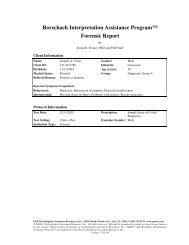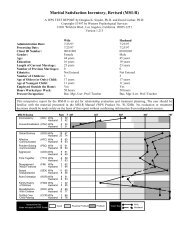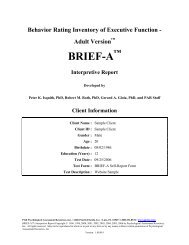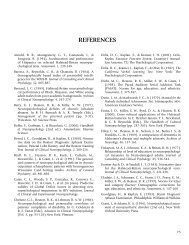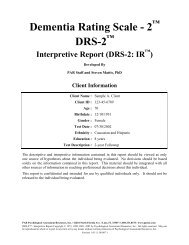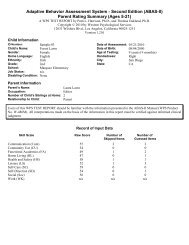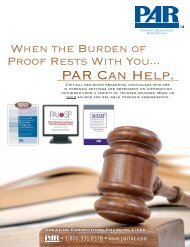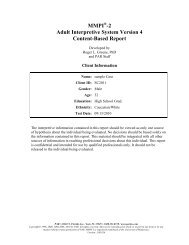PERSONALITY ASSESSMENT INVENTORY ... - ACER
PERSONALITY ASSESSMENT INVENTORY ... - ACER
PERSONALITY ASSESSMENT INVENTORY ... - ACER
Create successful ePaper yourself
Turn your PDF publications into a flip-book with our unique Google optimized e-Paper software.
<strong>PERSONALITY</strong> <strong>ASSESSMENT</strong> <strong>INVENTORY</strong> -ADOLESCENTClinical Interpretive ReportbyLeslie C. Morey, PhDand PAR StaffClient InformationName: Sample ClientClient ID: SC 01Gender: FemaleAge: 16Grade: 10 thDate of Birth: 02/05/1991Test Date: 11/08/2007Ethnicity: Caucasian/WhiteReferred By: Dr GerhardWorking Diagnosis: Mood Disorder NOSThe interpretive information contained in this report should be viewed as only one source ofhypotheses about the individual being evaluated. No decisions should be based solely on theinformation contained in this report. This material should be integrated with all other sourcesof information in reaching professional decisions about this individual.This report is confidential and intended for use by qualified professionals only. It should not bereleased to the individual being evaluated.PAR Psychological Assessment Resources, Inc. • 16204 North Florida Ave. • Lutz, FL 33549 • 1.800.331.8378 • www.parinc.comCopyright © 1990, 1991, 1993, 1995, 1998, 2000, 2005, 2007 by Psychological Assessment Resources, Inc. All rights reserved. May not bereproduced in whole or in part in any form or by any means without written permission of Psychological Assessment Resources, Inc.“Personality Assessment Inventory” is a trademark and “PAI” is a registered trademark owned by Psychological Assessment Resources, Inc.Version: 1.00 ( 1.00.007 )
Client: Sample Client Test Date: 11/08/2007Client ID: SC 01 Page 2 of 9Full Scale ProfileT score 110T score 110100100ANX9090ARDDEPDRG80SUISTR80NONBOR70PAR7060NIMSOMSCZANT60ICN5050INFWRMMANAGGALC4040PIM3030DOM 20Scale: ICN INF NIM PIM SOM ANX ARD DEP MAN PAR SCZ BOR ANT ALC DRG AGG SUI STR NON RXR DOM WRMRaw score: 5 3 6 6 15 51 44 40 17 32 22 42 27 0 15 14 15 15 13 0 2 13T score: 55 49 60 34 63 93 86 84 46 69 64 72 60 43 85 45 79 80 74 19 22 46% Completed: 100.0 100.0 100.0 100.0 100.0 100.0 100.0 100.0 100.0 100.0 100.0 100.0 100.0 100.0 100.0 100.0 100.0 100.0 100.0 100.0 100.0 100.0 20Plotted T scores are based upon a census matched standardization sample of 707 community adolescents 12 to 18 years of age.• indicates that the score is more than two standard deviations above the mean for a sample of 1,160 clinical patients. indicates that the scale has 20% or more missing items.
Client: Sample Client Test Date: 11/08/2007Client ID: SC 01 Page 3 of 9Subscale ProfileScoreRawT 30 40 50 60 70 80 90 100 110SOM-C Conversion 3 53SOM-S Somatization 10 79SOM-H Health Concerns 2 51ANX-C Cognitive 16 82ANX-A Affective 18 90ANX-P Physiological 17 91ARD-O Obsessive-Compulsive 11 61ARD-P Phobias 18 87ARD-T Traumatic Stress 15 76DEP-C Cognitive 15 84DEP-A Affective 10 73DEP-P Physiological 15 80MAN-A Activity Level 10 67MAN-G Grandiosity 0 27MAN-I Irritability 7 50PAR-H Hypervigilance 12 63PAR-P Persecution 8 64PAR-R Resentment 12 67SCZ-P Psychotic Experiences 6 58SCZ-S Social Detachment 8 61SCZ-T Thought Disorder 8 62BOR-A Affective Instability 12 72BOR-I Identity Problems 15 78BOR-N Negative Relationships 15 79BOR-S Self-Harm 0 36ANT-A Antisocial Behaviors 15 71ANT-E Egocentricity 9 63ANT-S Stimulus-Seeking 3 41AGG-A Aggressive Attitude 8 52AGG-V Verbal Aggression 0 30AGG-P Physical Aggression 6 54 30 40 50 60 70 80 90 100 110Plotted T scores are based upon a census matched standardization sample of 707 community adolescents 12 to 18 years of age.• indicates that the score is more than two standard deviations above the mean for a sample of 1,160 clinical patients. indicates that the scale has 20% or more missing items.
Client: Sample Client Test Date: 11/08/2007Client ID: SC 01 Page 4 of 9Validity of Test ResultsThe PAI-A provides a number of validity indices that are designed to provide an assessment offactors that could distort the results of testing. Such factors could include failure to completetest items properly, carelessness, reading difficulties, confusion, exaggeration, malingering, ordefensiveness. For this protocol, there are no uncompleted items.Also evaluated is the extent to which the respondent attended appropriately and respondedconsistently to the content of test items. The respondent’s scores suggest that she did attendappropriately to item content and responded in a consistent fashion to similar items.The degree to which response styles may have affected or distorted the report ofsymptomatology on the inventory is also assessed. The scores for these indicators fall in thenormal range, suggesting that the respondent answered in a reasonably forthright manner andthat there do not appear to be factors that might distort the profile which would make it appeareither more negative or more positive than the clinical picture would warrant.Clinical FeaturesThe PAI-A clinical profile is marked by significant elevations across several scales, indicating abroad range of clinical features and increasing the possibility of multiple diagnoses. Profilepatterns of this type are usually associated with marked distress and severe impairment infunctioning. The configuration of the clinical scales suggests a person with marked anxiety andtension. The respondent may be particularly uneasy and ruminative about her personalrelationships, some of which are probably not going well; these relationships may be animportant source of her current distress and she may be responding to these circumstances bybecoming socially withdrawn. The disruptions in her life have left her uncertain about hergoals and priorities, and tense and fearful about what the future may hold.The respondent reports a degree of anxiety that is unusual even in clinical samples. Her life isprobably severely constricted by her tension and she may not be able to meet even minimal roleexpectations without feeling overwhelmed. Relatively mild stressors may be sufficient toprecipitate a major crisis. She is likely to be plagued by worry to the degree that her ability toconcentrate and attend are significantly compromised, probably leading to a noticeable declinein her school performance. Peers are likely to comment about her overconcern regarding issuesand events over which she has no control. Affectively, she feels a great deal of tension, hasdifficulty relaxing, and likely experiences fatigue as a result of high perceived stress. Overtphysical signs of tension and stress, such as sweaty palms, trembling hands, complaints ofirregular heartbeats, and shortness of breath are also present.The respondent indicates that she is experiencing severe, specific fears or anxiety surroundingcertain situations; these fears are of a degree that is unusual even in clinical samples. Her life isprobably severely constricted by her psychological turmoil. Although efforts to control anxietyare probably present, these patterns are having little effect on preventing anxiety from intrudinginto experience and affecting functioning. The pattern of responses reveals that she is likely todisplay a variety of maladaptive behavior patterns aimed at controlling anxiety. She does notappear to have significant problems with obsessive-compulsive thoughts and behaviors.
Client: Sample Client Test Date: 11/08/2007Client ID: SC 01 Page 5 of 9However, phobic behaviors are likely to interfere in some significant way in her life, and it isprobable that she monitors her environment in a vigilant fashion to avoid contact with the fearedobject or situation. She is more likely to have multiple phobias or a more distressing phobia,such as agoraphobia, than to suffer from a simple phobia.In addition, and perhaps related to the above problems, the respondent has likely experienced adisturbing traumatic event in the past-an event that continues to distress her and producerecurrent episodes of anxiety. Whereas the item content of the PAI-A does not address specificcauses of traumatic stress, possible traumatic events involve life-threatening accidents,victimization (e.g., rape, abuse), and natural disasters.The respondent indicates that her use of drugs has been sufficient to have had negativeconsequences on her life. Problems associated with drug use appear to be noteworthy,including strained and family interpersonal relationships, school and/or legal problems, andpossible health complications.The respondent reports a number of difficulties consistent with a significant depressiveexperience. She is likely to be plagued by thoughts of worthlessness, hopelessness, andpersonal failure. She admits openly to feelings of sadness, a loss of interest in normalactivities, and a loss of sense of pleasure in things that were previously enjoyed. She is likelyto show a disturbance in sleep pattern, a decrease in level of energy and drive, and a loss ofappetite and/or weight. Psychomotor slowing might also be expected.The respondent describes a number of problematic personality traits. She reports problems ofmany different types. She is likely to be quite emotionally labile, manifesting fairly rapid andextreme mood swings and in particular probably experiences episodes of poorly controlledanger. She appears uncertain about major life issues and has little sense of direction or purposein her life as it currently stands. It is also likely that she has a history of involvement in intenseand volatile relationships and tends to be preoccupied with consistent fears of being abandonedor rejected by those around her.The respondent describes herself as being more wary and sensitive in interpersonal relationshipsthan the average adolescent. Others are likely to see her as tough-minded, skeptical, andsomewhat hostile.Certain elements of the respondent's self-description suggests that others are likely to see her asbeing withdrawn, aloof, and somewhat unconventional.The respondent indicates some concerns about physical functioning and health matters ingeneral. She reports particular problems with the frequent occurrence of various minorphysical symptoms (such as headaches, pain, or gastrointestinal problems) and has vaguecomplaints of ill health and fatigue. Her physical symptoms are often accompanied by somedepression and anxiety.Her responses suggest that she has a history of antisocial behavior and may be manifestingbehaviors consistent with a conduct disorder. She may have been involved in illegaloccupations or engaged in criminal acts involving theft, destruction of property, or physicalaggression toward others.According to the respondent’s self-report, she describes NO significant problems in thefollowing area: unusually elevated mood or heightened activity.
Client: Sample Client Test Date: 11/08/2007Client ID: SC 01 Page 6 of 9Self-ConceptThe self-concept of the respondent appears to be poorly established, although harshself-criticism and severe self-doubt seem characteristic. Her self-perception will tend to vary asa function of the current status of close relationships; apart from a sense of identity establishedfrom such relationships, she likely feels incomplete, unfulfilled, and inadequate. As a result,her self-esteem is quite fragile and is likely to plummet in response to slights or oversights byother people. Associated with this instability in self-esteem are corresponding shifts in identityand attitudes about major life issues, of a magnitude well beyond that typical of adolescents.Interpersonal and Social EnvironmentThe respondent’s interpersonal style seems best characterized as self-effacing and lackingconfidence in social interactions. She is likely to have difficulty in having her needs met inpersonal relationships and instead will subordinate her own interests to those of others in amanner that may seem self-punitive. Her failure to assert herself may result in mistreatment orexploitation by others, and it does not appear that this interpersonal strategy has been effectivein maintaining her most important relationships.In considering the social environment of the respondent with respect to perceived stressors andthe availability of social supports with which to deal with these stressors, her responses indicatethat she is likely to be experiencing notable stress and turmoil in a number of major life areas.A review of her current school situation, peer network, and family and/or close relationshipswill clarify the importance of these in the overall clinical picture. A primary source of stressmay involve relationship issues because she believes that her social relationships offer her littlesupport; family relationships may be somewhat distant or ridden with conflict, and friends maynot be available when needed. Interventions directed at key problematic relationships (such asthose involving family problems) may be of some use in alleviating what may be a major sourceof dissatisfaction.Treatment ConsiderationsTreatment considerations involve issues that can be important elements in case management andtreatment planning. Interpretation is provided for three general areas relevant to treatment:behaviors that may serve as potential treatment complications, motivation for treatment, andaspects of the respondent’s clinical picture that may complicate treatment efforts.With respect to suicidal ideation, the respondent reports experiencing recurrent thoughts relatedto a suicidal act. Although only a small percentage of individuals who entertain suicidalthoughts actually act upon them, a score in this range should be considered a significant warningsign of the potential for suicide, regardless of the levels of elevation on other scales. A carefulfollow-up regarding the details of her suicidal thoughts and the potential for suicidal behavior iswarranted, as is an evaluation of her life circumstances and available support systems aspotential mediating factors.With respect to anger management, the respondent describes her temper as within the normalrange, and as fairly well-controlled without apparent difficulty.
Client: Sample Client Test Date: 11/08/2007Client ID: SC 01 Page 7 of 9The respondent’s interest in and motivation for treatment is typical of individuals being seen intreatment settings and she appears more motivated for treatment than adolescents who are notbeing seen in a therapeutic setting. Her responses suggest an acknowledgement of importantproblems and the perception of a need for help in dealing with these problems. She reports apositive attitude towards the possibility of personal change, the value of therapy, and theimportance of personal responsibility. However, the nature of some of these problems suggeststhat treatment would be fairly challenging, with a difficult treatment process and the probabilityof reversals.If treatment were to be considered for this individual, particular areas of attention or concern inthe early stages of treatment could include:Current difficulties in her social support system may give a special significance to thetherapeutic relationship and any impasse may need to be handled with particular care.She may have initial difficulty in placing trust in a treating professional as part of her moregeneral problems in close relationships.She may currently be too disorganized or feel too overwhelmed to be able to participatemeaningfully in some forms of treatment.DSM-IV Diagnostic PossibilitiesThe following DSM-IV Diagnostic Possibilities are suggestions for further investigation. Adiagnosis should be made only after careful examination of the specific DSM-IV diagnosticcriteria and should be informed by clinical judgment.Axis I:Axis I Rule Out:296.20 Major Depressive Disorder, Single Episode, Unspecified300.21 Panic Disorder With Agoraphobia305.90 Other (or Unknown) Substance Abuse301.13 Cyclothymic Disorder309.81 Posttraumatic Stress Disorder300.02 Generalized Anxiety Disorder312.89 Conduct Disorder, Unspecified Onset300.29 Specific Phobia300.81 Somatization DisorderAxis II: 799.9 Diagnosis or condition deferred on Axis IIAxis II Rule Out:301.83 Borderline Personality Disorder
Client: Sample Client Test Date: 11/08/2007Client ID: SC 01 Page 8 of 9Critical Item EndorsementA total of 17 PAI-A items reflecting serious pathology have very low endorsement rates innormal samples. These items have been termed critical items. Endorsement of these criticalitems is not in itself diagnostic, but review of the content of these items with the respondent mayhelp to clarify the presenting clinical picture. Endorsed Critical Items, i.e. items with an itemscore of 1, 2, or 3, are indicated by a bolded Item Response in the table below.ItemScaleItemResponseItem TextDelusions and Hallucinations35 SCZ-T ST [Item text was removed from this report for sample purposes.]128 SCZ-P VT [Item text was removed from this report for sample purposes.]222 PAR-P ST [Item text was removed from this report for sample purposes.]Potential for Self-Harm79 BOR-S F [Item text was removed from this report for sample purposes.]165 DEP-A F [Item text was removed from this report for sample purposes.]262 SUI F [Item text was removed from this report for sample purposes.]Potential for Aggression58 AGG-P F [Item text was removed from this report for sample purposes.]138 AGG-P F [Item text was removed from this report for sample purposes.]Substance Abuse60 DRG VT [Item text was removed from this report for sample purposes.]217 ALC F [Item text was removed from this report for sample purposes.]Traumatic Stressors191 ARD-T F [Item text was removed from this report for sample purposes.]231 ARD-T VT [Item text was removed from this report for sample purposes.]Potential Malingering/Negative Distortion13 NIM F [Item text was removed from this report for sample purposes.]213 NIM F [Item text was removed from this report for sample purposes.]Unreliability89 ANT-A VT [Item text was removed from this report for sample purposes.]129 ANT-A F [Item text was removed from this report for sample purposes.]199 BOR-S F [Item text was removed from this report for sample purposes.]Note. VT = “Very True”, MT = “Mainly True”, ST = “Slightly True”, F = “False, Not At All True”.
Client: Sample Client Test Date: 11/08/2007Client ID: SC 01 Page 9 of 9PAI-A Item ResponsesItem Resp. Item Resp. Item Resp. Item Resp. Item Resp. Item Resp.1. VT 45. ST 89. VT 133. VT 177. F 221. F2. F 46. ST 90. F 134. F 178. VT 222. ST3. VT 47. F 91. F 135. VT 179. F 223. VT4. VT 48. F 92. VT 136. VT 180. F 224. VT5. F 49. VT 93. F 137. F 181. F 225. F6. F 50. MT 94. F 138. F 182. VT 226. MT7. VT 51. F 95. ST 139. F 183. F 227. F8. VT 52. VT 96. VT 140. F 184. VT 228. VT9. VT 53. F 97. F 141. VT 185. VT 229. F10. F 54. VT 98. F 142. VT 186. VT 230. ST11. VT 55. MT 99. F 143. F 187. VT 231. VT12. VT 56. F 100. F 144. VT 188. VT 232. F13. F 57. F 101. VT 145. VT 189. F 233. ST14. VT 58. F 102. F 146. F 190. VT 234. VT15. VT 59. F 103. F 147. F 191. F 235. ST16. ST 60. VT 104. F 148. F 192. VT 236. F17. VT 61. VT 105. F 149. VT 193. VT 237. F18. F 62. ST 106. VT 150. VT 194. F 238. F19. F 63. F 107. F 151. VT 195. F 239. F20. VT 64. F 108. VT 152. F 196. F 240. F21. VT 65. F 109. VT 153. F 197. ST 241. F22. F 66. F 110. F 154. F 198. F 242. VT23. VT 67. F 111. VT 155. VT 199. F 243. VT24. VT 68. VT 112. F 156. F 200. F 244. VT25. VT 69. MT 113. F 157. F 201. VT 245. VT26. F 70. VT 114. VT 158. VT 202. F 246. VT27. VT 71. VT 115. F 159. F 203. VT 247. MT28. VT 72. F 116. F 160. VT 204. MT 248. MT29. VT 73. VT 117. F 161. VT 205. F 249. MT30. VT 74. F 118. VT 162. F 206. VT 250. VT31. VT 75. VT 119. F 163. VT 207. VT 251. F32. VT 76. F 120. F 164. F 208. F 252. VT33. F 77. VT 121. VT 165. F 209. F 253. F34. VT 78. VT 122. F 166. VT 210. F 254. F35. ST 79. F 123. F 167. VT 211. VT 255. F36. F 80. VT 124. VT 168. F 212. ST 256. F37. ST 81. VT 125. VT 169. F 213. F 257. F38. VT 82. F 126. F 170. VT 214. F 258. VT39. F 83. F 127. VT 171. VT 215. F 259. VT40. F 84. F 128. VT 172. VT 216. VT 260. F41. VT 85. VT 129. F 173. VT 217. F 261. F42. VT 86. VT 130. F 174. VT 218. VT 262. F43. VT 87. VT 131. F 175. F 219. VT 263. ST44. F 88. F 132. VT 176. VT 220. F 264. FNote. VT = “Very True”, MT = “Mainly True”, ST = “Slightly True”, F = “False, Not At All True”, ? = Item is missing.End of Report


